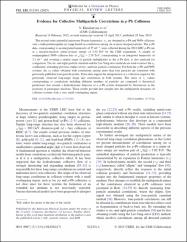| dc.contributor.author | Khachatryan, V. | |
| dc.contributor.author | Sirunyan, A. M. | |
| dc.contributor.author | Tumasyan, A. | |
| dc.contributor.author | Adam, W. | |
| dc.contributor.author | Bergauer, T. | |
| dc.contributor.author | Dragicevic, M. | |
| dc.contributor.author | Özdemir, Kadri | |
| dc.contributor.author | CMS Collaboration | |
| dc.date.accessioned | 2021-06-05T20:01:09Z | |
| dc.date.available | 2021-06-05T20:01:09Z | |
| dc.date.issued | 2015 | |
| dc.identifier.issn | 0031-9007 | |
| dc.identifier.issn | 1079-7114 | |
| dc.identifier.uri | https://doi.org/10.1103/PhysRevLett.115.012301 | |
| dc.identifier.uri | https://hdl.handle.net/20.500.12960/1066 | |
| dc.description | PubMed: 26182092 | en_US |
| dc.description | WOS:000357030500003 | en_US |
| dc.description.abstract | The second-order azimuthal anisotropy Fourier harmonics, nu(2), are obtained in p-Pb and PbPb collisions over a wide pseudorapidity (.) range based on correlations among six or more charged particles. The p-Pb data, corresponding to an integrated luminosity of 35 nb(-1), were collected during the 2013 LHC p-Pb run at a nucleon-nucleon center-of-mass energy of 5.02 TeV by the CMS experiment. A sample of semiperipheral PbPb collision data at root S-NN = 2.76 TeV, corresponding to an integrated luminosity of 2.5 mu b(-1) and covering a similar range of particle multiplicities as the p-Pb data, is also analyzed for comparison. The six-and eight-particle cumulant and the Lee-Yang zeros methods are used to extract the nu(2) coefficients, extending previous studies of two-and four-particle correlations. For both the p-Pb and PbPb systems, the nu(2) values obtained with correlations among more than four particles are consistent with previously published four-particle results. These data support the interpretation of a collective origin for the previously observed long-range (large..) correlations in both systems. The ratios of nu(2) values corresponding to correlations including different numbers of particles are compared to theoretical predictions that assume a hydrodynamic behavior of a p-Pb system dominated by fluctuations in the positions of participant nucleons. These results provide new insights into the multiparticle dynamics of collision systems with a very small overlapping region. | en_US |
| dc.language.iso | eng | en_US |
| dc.publisher | Amer Physical Soc | en_US |
| dc.relation.ispartof | Physical Review Letters | en_US |
| dc.rights | info:eu-repo/semantics/openAccess | en_US |
| dc.subject | Fizik | en_US |
| dc.subject | Physics | en_US |
| dc.title | Evidence for Collective Multiparticle Correlations in p-Pb Collisions | en_US |
| dc.type | article | en_US |
| dc.authorid | 0000-0002-0103-1488 | |
| dc.department | Mühendislik Fakültesi, Elektrik-Elektronik Mühendisliği Bölümü | en_US |
| dc.contributor.institutionauthor | Özdemir, Kadri | |
| dc.identifier.doi | 10.1103/PhysRevLett.115.012301 | |
| dc.identifier.volume | 115 | en_US |
| dc.identifier.issue | 1 | en_US |
| dc.relation.publicationcategory | Makale - Uluslararası Hakemli Dergi - Kurum Öğretim Elemanı | en_US |

















